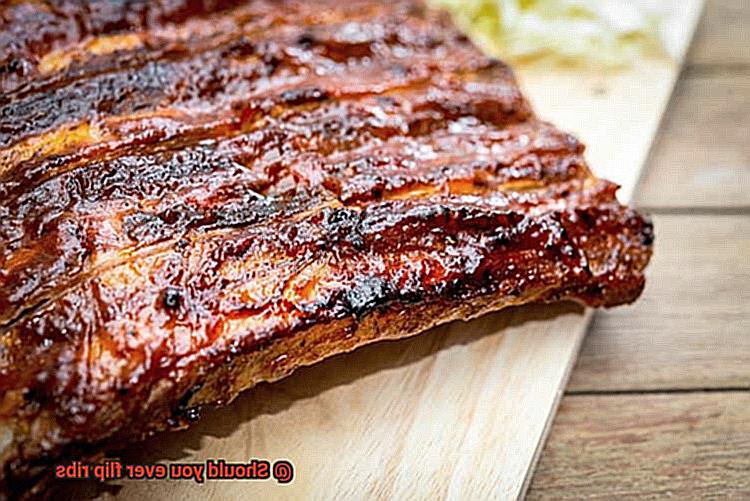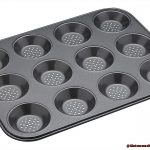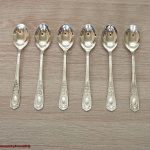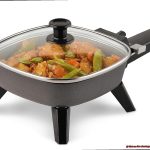The tantalizing aroma of BBQ ribs can make anyone’s mouth water, especially during summer cookouts. Whether you’re a fan of sweet and sticky sauce or prefer a more savory, dry rub flavor, ribs have become an American classic. But when it comes to cooking them, there’s a heated debate about whether or not to flip them.
Some grill masters swear that flipping is a cardinal sin that results in tough, dry meat falling off the bone. Others argue that flipping is vital for even cooking and ensures the sauce or rub is evenly distributed. So what’s the truth? Should you flip your ribs or not?
In this blog post, we’ll dive into the pros and cons of flipping your ribs and provide expert tips to help you achieve the perfect barbecue every time. From understanding the science behind the cooking process to mastering the art of flipping, we’ll examine all factors that contribute to creating mouth-watering ribs. So grab your tongs and let’s get grilling.
Contents
What Is Grilling Ribs?
Grilling ribs is a culinary adventure that requires patience, skill, and the right technique. Whether you’re a seasoned grilling pro or a beginner, mastering the art of grilling ribs is essential if you want to impress your guests with mouth-watering meat that’s cooked to perfection.
First things first, selecting the right cut of meat is crucial. Pork ribs are the most popular choice, but if you’re feeling adventurous, beef ribs can also be grilled. Baby back ribs and spare ribs are the most common cuts of pork ribs, but whatever your choice may be, ensure that it’s fresh and high-quality.
Once you have your meat, it’s time to prepare it for grilling. Prep work may involve removing the membrane from the bone side of the ribs, trimming off any excess fat, and seasoning the meat with your favorite rub or marinade. You can either use store-bought seasonings or make your own by mixing together an array of spices like garlic powder, onion powder, paprika, and cumin.
When it comes to grilling ribs, using indirect heat is key. This means placing the meat on one side of your grill and using the other side for flames or charcoal. By doing so, you’ll get a smoky flavor and crispy texture that’s hard to achieve with other cooking methods. To add an extra layer of smoky flavor, consider adding wood chips or chunks to your grill.
Grilling ribs can take anywhere from 1-4 hours depending on the cut of meat and your desired level of doneness. During this time, it’s vital to monitor the temperature of the grill and the internal temperature of the meat to ensure it’s cooked safely. Use a meat thermometer as a great tool for checking the internal temperature of your ribs – aim for 145°F for pork and 135°F for beef.
Now comes the controversial part – flipping or not flipping your ribs. Some experts argue that flipping helps prevent burning and ensures even cooking, while others believe it can cause the meat to lose moisture and flavor. Ultimately, the decision is yours to make based on your personal preference and cooking style.
Pros of Flipping Ribs
While some argue that flipping can dry out the meat and rob it of flavor, I am here to share with you the many benefits of flipping those succulent ribs.
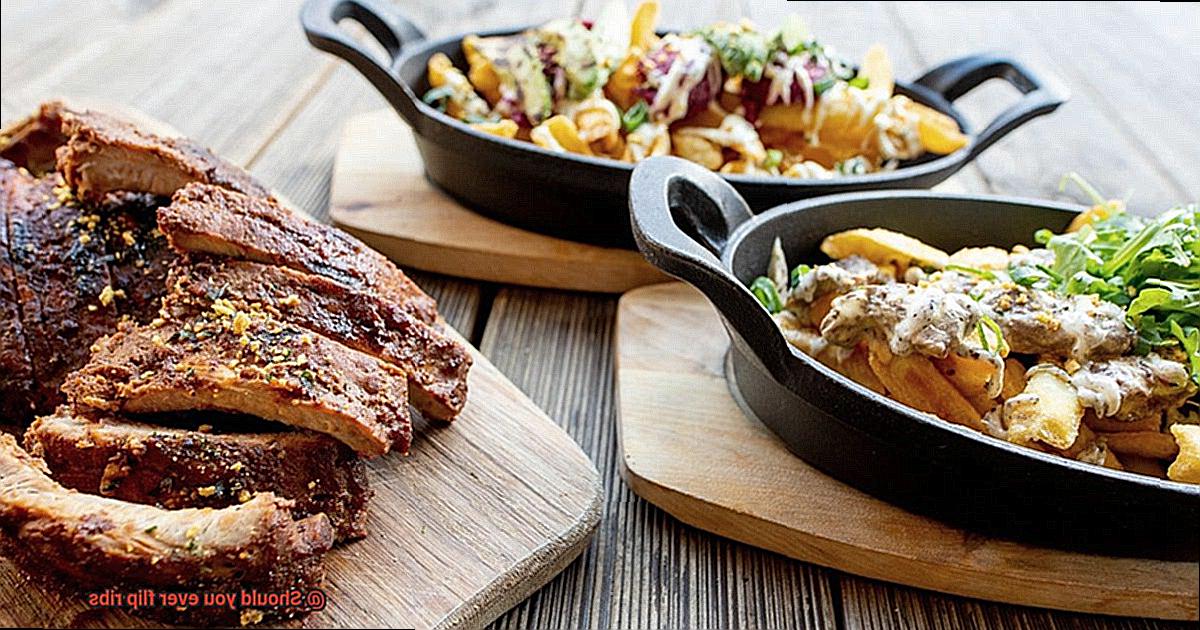
Firstly, flipping your ribs can prevent burning and overcooking. Leaving them on one side for too long can cause the heat to become too intense and char the meat. By flipping them, you ensure even cooking and reduce the risk of burning or overcooking.
But that’s not all. Flipping ribs can also create a more flavorful crust on the meat. By exposing both sides to direct heat, any rubs or marinades on the meat are given a consistent caramelization, resulting in a burst of delicious flavor in every bite.
In addition to enhancing flavor, flipping ribs ensures that the meat is cooked evenly throughout. While slow cooking is often used to achieve tender and juicy ribs, flipping them guarantees that all parts of the meat are exposed to heat and cooked properly. This results in a texture and taste that is consistently divine.
So why not try flipping your next batch of ribs? The benefits are clear: evenly cooked, flavorful, and perfectly grilled ribs. Of course, personal preference plays a role in deciding how to cook your ribs, but if you’re looking for a lip-smacking meal that will make your taste buds sing, then flipping is definitely worth considering.
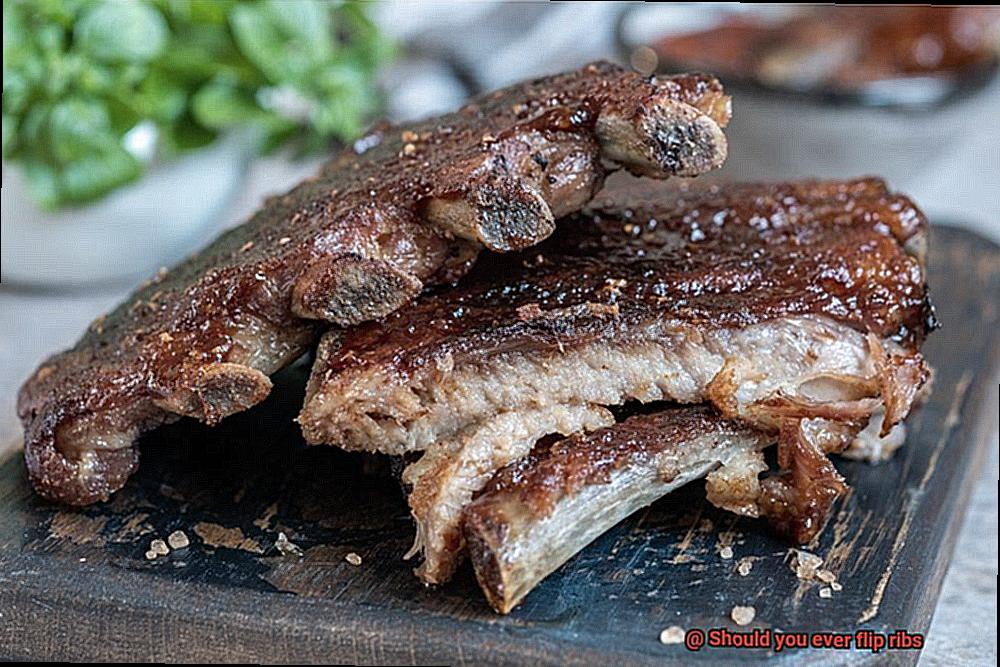
Cons of Flipping Ribs
While it may seem like a necessary step for even cooking and those coveted grill marks, there are actually some downsides to this technique. So, before you flip those slabs of meat, consider these cons:
One of the biggest drawbacks of flipping ribs is the loss of moisture. Each time you flip them, juices escape and evaporate, leading to dry and tough meat. To avoid this, leave your ribs undisturbed on the grill for a longer period of time to lock in those juices.
Another issue that can arise from flipping too early is sticking. Ribs might tear apart or lose their shape when they stick to the grill grates, causing the meat to dry out and decreasing its quality. Instead, wait for your ribs to release naturally before giving them a flip.
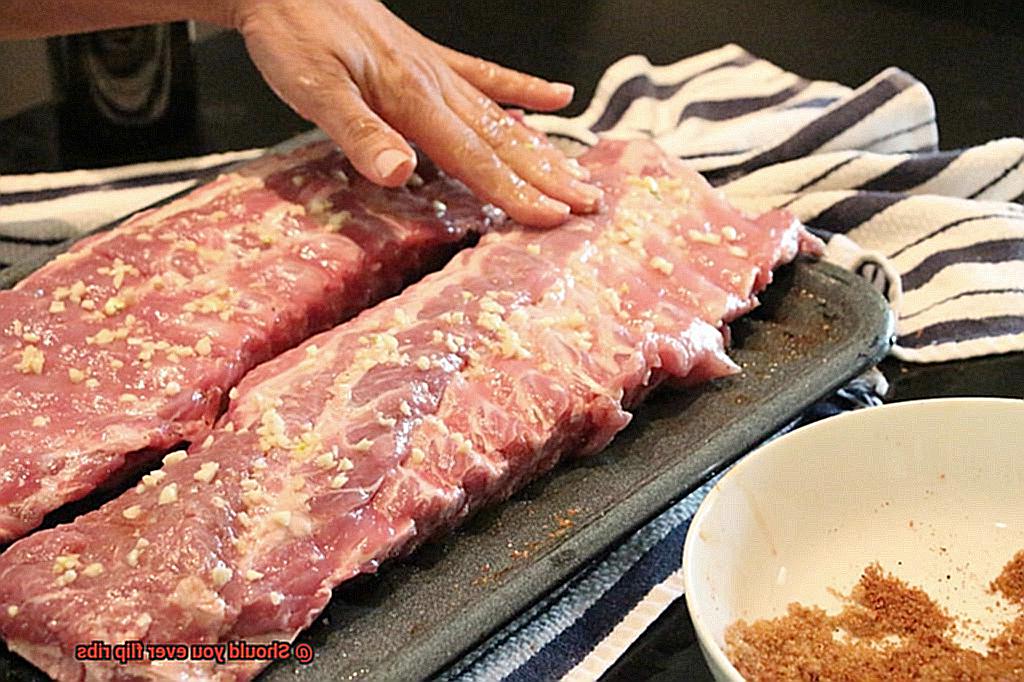
Uneven cooking is another potential problem with flipping ribs too often. This can lead to some parts of the meat being overcooked while others remain undercooked, resulting in an unappetizing texture and flavor.
Finally, flipping ribs too often can delay the cooking process. The temperature inside the grill drops each time you flip them, which means it’ll take longer for your ribs to cook through properly. So, if you’re short on time or have hungry guests waiting, consider leaving your ribs alone and letting them cook in peace.
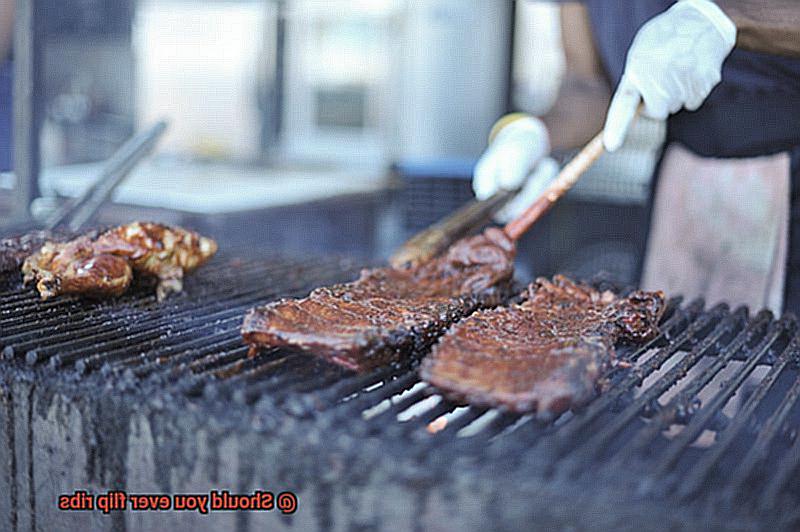
Different Techniques for Grilling Ribs
There are several techniques you can use to achieve the ultimate texture and flavor, depending on your personal preference and the cut of meat you’re using.
The indirect grilling method is a popular choice for achieving slow and steady cooking, resulting in tender and juicy meat. To do this, set up your grill with the heat source on one side and place the ribs on the opposite side. Keep a close eye on the temperature and adjust the heat source as needed for optimal results.
If you’re looking for a mouth-watering experience, the “low and slow” method is for you. Cook your ribs at a low temperature, around 225°F for several hours until they reach an internal temperature of around 190°F. This technique allows for the connective tissue in the meat to break down slowly, resulting in a tender and flavorful end product.
When it comes to flipping your ribs, there are differing opinions among grill masters. Some argue that flipping too often can cause dryness or toughness, while others believe that regularly flipping ensures even cooking and prevents burning. Ultimately, it’s up to personal preference and the technique you choose.
To ensure maximum flavor and moisture, seasoning is key. Generously season your meat with a flavorful rub or marinade before cooking. This will infuse the meat with flavor and ensure it stays moist during cooking. Monitoring the temperature of your grill closely is also crucial to prevent undercooking or burning.
How to Flip Ribs Properly
Whatever your reasons, flipping ribs properly is essential for achieving juicy, flavorful results. Here are five tips to help you flip ribs like a pro.
Choose the Right Tools
Using the right tools will make all the difference when it comes to flipping ribs. Avoid using a fork or other sharp utensil, as this can tear the meat and cause it to dry out. Instead, opt for tongs or a spatula to gently handle your ribs.
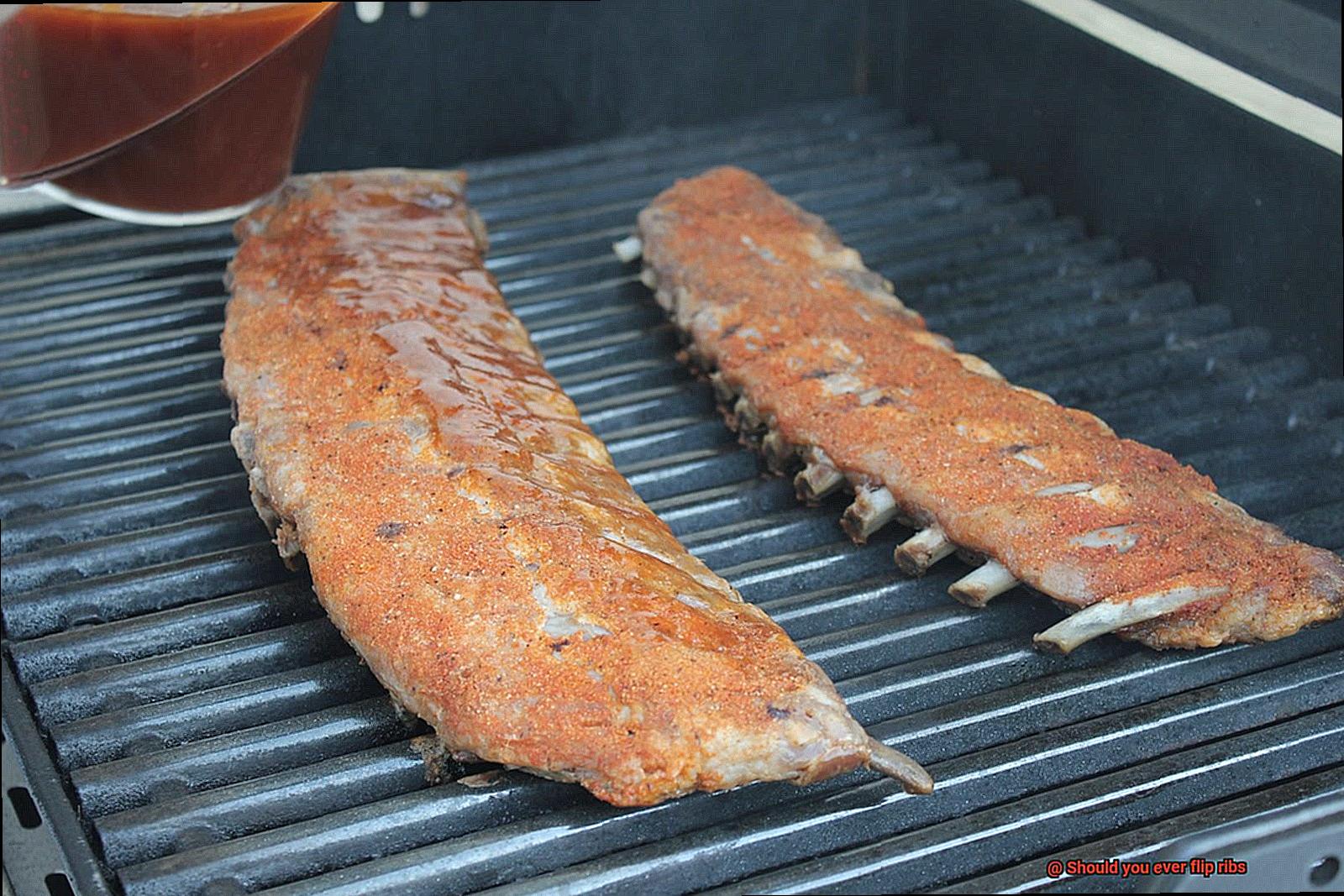
Timing is Everything
Timing is key when it comes to flipping ribs. Wait until the first side has developed a good char and has started to release easily from the grill grates before flipping. This will help prevent tearing and ensure even cooking. If grilling over direct heat, flip your ribs at least once to cook both sides evenly.
Don’t Overdo It
While flipping is necessary for even cooking, overflipping can cause ribs to dry out and become tough. Ideally, ribs should only be flipped once or twice during the cooking process.
Keep Your Workspace Clear
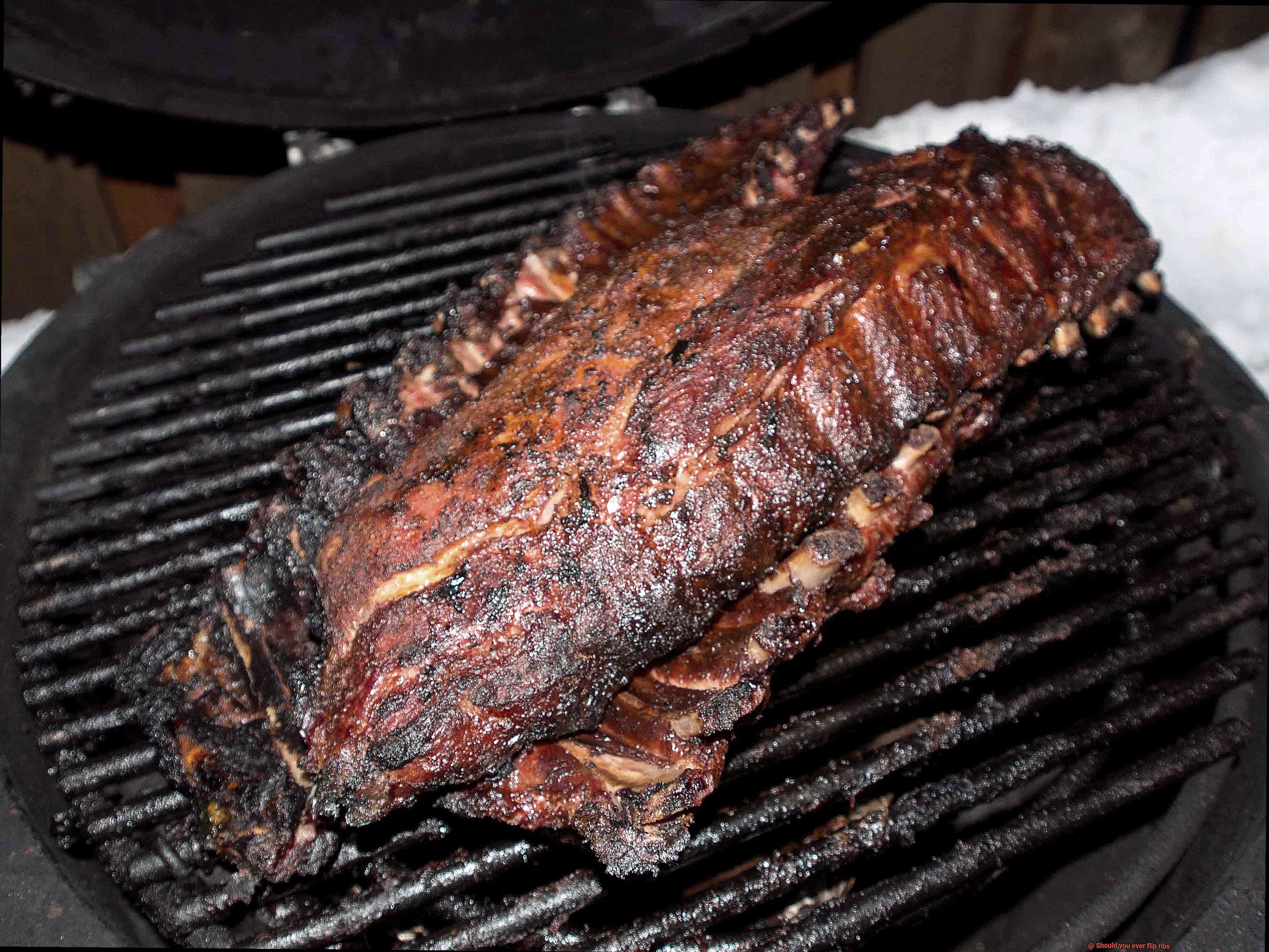
When flipping ribs, it’s important to have a clear workspace and a safe place to set down hot tongs or spatulas. Use a clean plate or platter nearby to make flipping easier and safer.
Consider Your Cooking Method
The need for flipping depends on your chosen cooking method. For example, if cooking in an oven or slow cooker, there’s no need to flip as they cook evenly on both sides. However, if you prefer a crispy exterior on your ribs, broiling them in the oven for a few minutes after cooking can do the trick.
Tips for Avoiding Burning and Uneven Cooking
Grilling ribs is a mouthwatering and popular way to cook this tasty cut of meat. However, it can be easy to burn or unevenly cook your ribs if you’re not careful. Luckily, there are some simple tips and techniques that you can use to ensure your ribs come out perfectly cooked every time.
Tip #1: Clean and heat up your grill properly.
Before cooking your ribs, make sure that your grill is clean and heated up properly. This will help prevent any leftover food or debris from causing hot spots or flare-ups that can lead to burning and uneven cooking.
Tip #2: Use indirect heat to cook your ribs.
Placing the ribs on a cooler part of the grill and cooking them slowly over a longer period of time can help prevent burning while allowing the meat to cook evenly. This will give you tender and juicy ribs.
Tip #3: Monitor the temperature of the grill and the meat throughout the cooking process.
Using a meat thermometer can help ensure that the ribs are cooked to the proper temperature, while adjusting the heat as needed can help prevent burning. Aim for an internal temperature of 145-165 degrees Fahrenheit.
Tip #4: Flip your ribs frequently.
Flipping your ribs can help prevent burning and ensure even cooking. This allows for both sides of the ribs to cook evenly. Some experts recommend flipping ribs only once during the cooking process, but others suggest flipping them more frequently to prevent burning and promote even cooking.
Tip #5: Baste with sauce at the right time.
Basting your ribs with sauce can help prevent them from drying out and burning. However, it’s important to wait until the last few minutes of cooking before applying the sauce, as sugar in the sauce can burn quickly. Brushing on sauce during the last 10-15 minutes of grilling is ideal.
Benefits of Not Flipping Ribs
When it comes to grilling ribs, there is a hot debate around whether or not flipping them is necessary. However, as an expert on the topic, I will tell you that there are several benefits to leaving your ribs untouched.
Firstly, by not flipping the ribs, you’re allowing the natural juices of the meat to stay locked in, resulting in a deliciously moist and flavorful final product. When you flip the ribs, those juices that have been collecting on top will run off and be lost forever. So, why not let them continue to soak into the meat?
But that’s not all – not flipping the ribs can also create a crispy exterior. By leaving them in one position, one side can become slightly charred and crispy, while the other remains tender. This contrast in textures can elevate the overall eating experience and leave your taste buds wanting more.
Another benefit of not flipping ribs is that it allows for a more hands-off approach. Flipping can be a hassle, especially when you’re cooking for a large group or trying to manage multiple dishes at once. By leaving the ribs untouched, you can focus on other aspects of your meal without worrying about constantly tending to the grill.
And let’s not forget about tradition – many old-school pitmasters believe that the best way to cook ribs is by setting them and forgetting them. By not flipping the ribs, you’re staying true to these traditional techniques and creating an authentic barbecue experience that honors classic barbecue techniques.
Common Mistakes When Grilling Ribs
These errors can lead to dry, tough, or burnt ribs that are far from perfect. Fortunately, with a few simple tips and tricks, you can avoid these pitfalls and achieve rib-grilling excellence.
Firstly, one of the biggest mistakes you can make when grilling ribs is not flipping them enough or flipping them too often. Flipping the ribs helps to ensure that they cook evenly on both sides and prevents burning. However, it’s important not to flip them too frequently as this can cause the meat to become dry and tough. So, aim to flip your ribs a few times throughout the cooking process while keeping an eye on the grill’s temperature.
Another crucial mistake is not preparing your ribs adequately before cooking. Simply throwing your ribs on the grill without removing the membrane or seasoning them will result in lackluster results. To avoid this, take the time to remove the membrane on the back of the ribs and season them well with a dry rub or marinade. This will help add flavor and tenderize the meat for a mouth-watering result.
Next up is controlling the temperature of your grill. Ribs should be cooked low and slow over indirect heat to allow the fat to render and the meat to become tender. If the temperature is too high, however, the ribs will cook too quickly and can become tough. Therefore, be sure to keep a close eye on your grill’s temperature and adjust it as needed.
Finally, not giving enough time for your ribs to rest after cooking is another common mistake. Resting allows the juices to redistribute throughout the meat, resulting in more flavorful and tender ribs. So, try to resist the urge to dig in right away and let your ribs rest for at least 10-15 minutes before serving.
Conclusion
In conclusion, the debate on whether to flip ribs or not has been a hot topic among grill masters for years. While some argue that flipping can siphon away the meat’s flavor and dry it out, others believe it is essential for even cooking and uniform sauce or rub distribution. Ultimately, the decision lies with you based on your personal preference and cooking style.
To achieve mouth-watering barbeque every time, selecting the right cut of meat, preparing it correctly with a flavorful marinade or rub, and using indirect heat are all vital steps. Keeping a close eye on your grill’s temperature and using a meat thermometer to check your rib’s internal temperature are also crucial for ensuring safe and delicious results.
Whether you choose to flip your ribs or not, there are pros and cons to weigh. Flipping can prevent burning, create a more delectable crust on the meat, and ensure even cooking throughout. However, flipping too frequently can lead to dryness or toughness due to moisture loss.
Avoiding common mistakes such as under-preparing your ribs before cooking, monitoring your grill’s temperature closely, flipping too often or not enough, and neglecting to give enough time for resting after cooking can help you achieve mouth-watering results every time.

